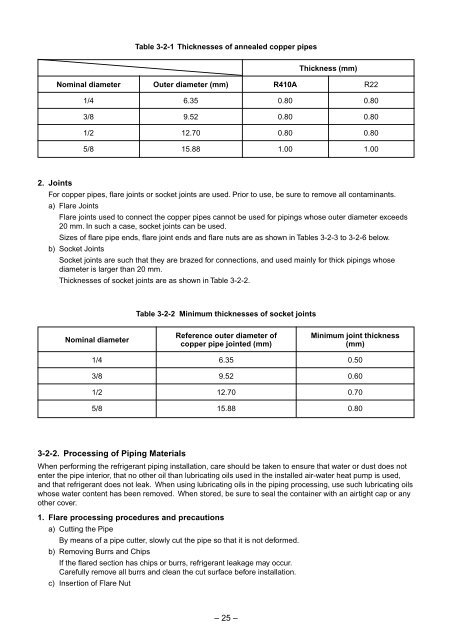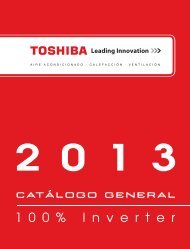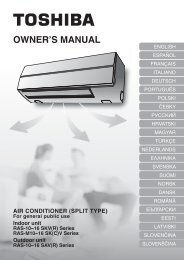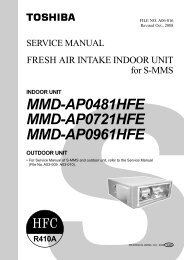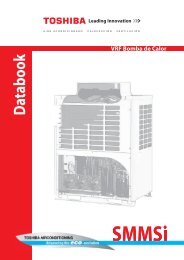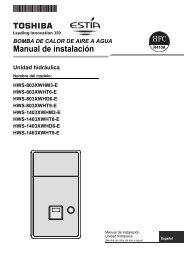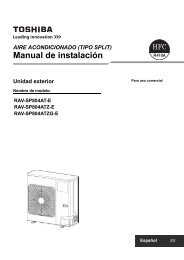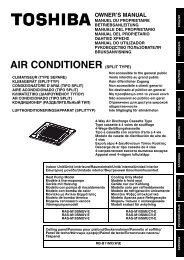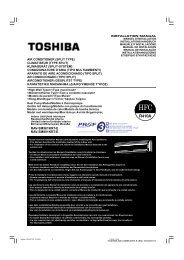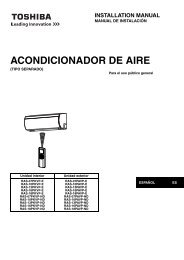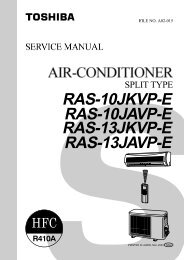SERVICE MANUAL - Alarko Carrier
SERVICE MANUAL - Alarko Carrier
SERVICE MANUAL - Alarko Carrier
You also want an ePaper? Increase the reach of your titles
YUMPU automatically turns print PDFs into web optimized ePapers that Google loves.
Table 3-2-1 Thicknesses of annealed copper pipes<br />
Thickness (mm)<br />
Nominal diameter<br />
Outer diameter (mm)<br />
R410A<br />
R22<br />
1/4<br />
3/8<br />
1/2<br />
5/8<br />
6.35<br />
9.52<br />
12.70<br />
15.88<br />
0.80 0.80<br />
0.80 0.80<br />
0.80 0.80<br />
1.00 1.00<br />
2. Joints<br />
For copper pipes, flare joints or socket joints are used. Prior to use, be sure to remove all contaminants.<br />
a) Flare Joints<br />
Flare joints used to connect the copper pipes cannot be used for pipings whose outer diameter exceeds<br />
20 mm. In such a case, socket joints can be used.<br />
Sizes of flare pipe ends, flare joint ends and flare nuts are as shown in Tables 3-2-3 to 3-2-6 below.<br />
b) Socket Joints<br />
Socket joints are such that they are brazed for connections, and used mainly for thick pipings whose<br />
diameter is larger than 20 mm.<br />
Thicknesses of socket joints are as shown in Table 3-2-2.<br />
Table 3-2-2 Minimum thicknesses of socket joints<br />
Nominal diameter<br />
1/4<br />
3/8<br />
1/2<br />
5/8<br />
Reference outer diameter of<br />
copper pipe jointed (mm)<br />
6.35<br />
9.52<br />
12.70<br />
15.88<br />
Minimum joint thickness<br />
(mm)<br />
0.50<br />
0.60<br />
0.70<br />
0.80<br />
3-2-2. Processing of Piping Materials<br />
When performing the refrigerant piping installation, care should be taken to ensure that water or dust does not<br />
enter the pipe interior, that no other oil than lubricating oils used in the installed air-water heat pump is used,<br />
and that refrigerant does not leak. When using lubricating oils in the piping processing, use such lubricating oils<br />
whose water content has been removed. When stored, be sure to seal the container with an airtight cap or any<br />
other cover.<br />
1. Flare processing procedures and precautions<br />
a) Cutting the Pipe<br />
By means of a pipe cutter, slowly cut the pipe so that it is not deformed.<br />
b) Removing Burrs and Chips<br />
If the flared section has chips or burrs, refrigerant leakage may occur.<br />
Carefully remove all burrs and clean the cut surface before installation.<br />
c) Insertion of Flare Nut<br />
– 25 –


